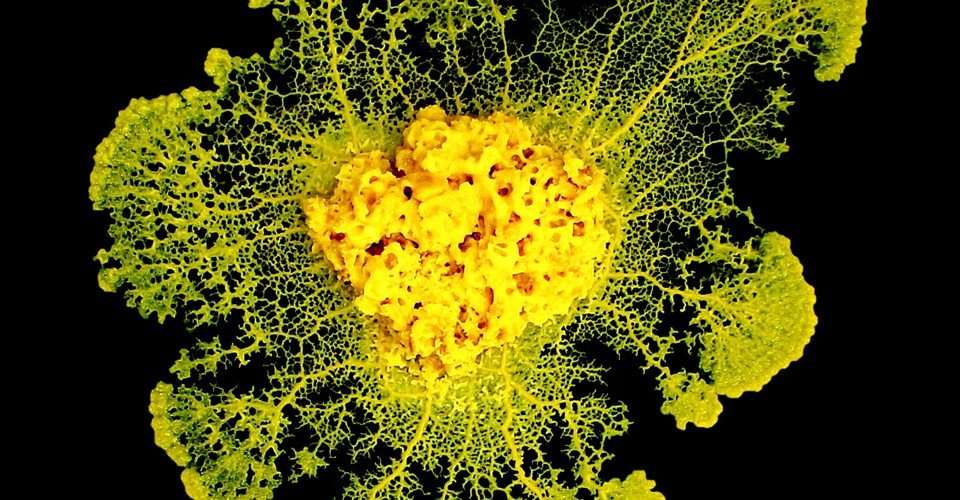The plasmodium is essentially a flat, liquid-filled sac, but as I wrote a few years back, “it behaves like a colony. Every part rhythmically expands and contracts, pushing around the fluid inside. If one part of the plasmodium touches something attractive, like food, it pulses more quickly and widens. If another part meets something repulsive, like light, it pulses more slowly and shrinks. By adding up all of these effects, the plasmodium flows in the best possible direction without a single conscious thought. It is the ultimate in crowdsourcing.”
This simple behavior can produce extraordinary results. The slime mold can make effective decisions, comparing different options and selecting the best one. It can balance its diet, solve mazes, and escape from traps. It can be integrated into microchips and machines and used to drive robots—not quite a driverless car, but certainly a vehicle with no brain behind the wheel.
It can also rival organisms with brains—like human engineers. In 2009, Atsushi Tero, from Hokkaido University, released a slime mold onto a Petri dish modeled on a map of the Greater Tokyo Area, with bits of food standing in for major urban centers. As the plasmodium sent its tendrils over the map, it continually changed its branches, strengthening some and weakening others. After a day, it had created a network that was almost identical to Tokyo’s actual rail network. Human designers had created that network to be as efficient as possible; the slime mold had done the same, but without any brainpower.
Andrew Adamatzky, from the University of West England, later repeated the experiment with maps of other countries including the U.K., Belgium, Mexico, Netherlands, Canada, Spain, China, Brazil, and the U.S. “We found that the slime mold approximated almost all interstates,” he wrote in the New York Times.
Earlier this year, Dussutour showed that slime molds can learn—at least, to a simple degree. She presented them with an obstacle course: To reach some food, they had to crawl over a bridge that was laced with repellents like salt or coffee. At first, the molds were clearly repulsed, and were slow to ooze across. With more repetitions, they became habituated; they got used to the chemicals, started ignoring them, and moved faster. And if Dussutour gave them a long timeout, and then reintroduced them to the bridge, they were just as reluctant to cross as they originally were.
Habituation is one of the simplest forms of learning, but slime molds show all its hallmarks. They get used to the chemicals with repeated exposure, and then become newly sensitized once exposure is withdrawn. Their behavior changes based on their experiences, and they retain a kind of primitive memory. “Most people thought that it was impossible for a cell to learn,” says Dussutour, “but we’ve tried this now with more than 2,000 slime molds. It can’t be an accident.”

hellogreeksalad on March 17th, 2019 at 13:15 UTC »
Stretch a rubber band around 3 nails, and you will get an optimal connection . The rubber band did that, without a brain!
eattyrat on March 17th, 2019 at 12:36 UTC »
I'm sorry, looking at the video at 3:31 where they drop the rail system map over the mold and they look not at all identical.
misof on March 17th, 2019 at 12:24 UTC »
The article itself is fine, but the sensationalist summary contained in the quoted sentence "Human designers had created that network to be as efficient as possible; the slime mold had done the same, but without any brainpower." is so dumb it hurts.
I'm all for popularizing science, but this is not the way to do it. Articles like this one often try to go for the sensational presentation of the type "ooh, slime mold without any brain can solve complex optimization problems". This is false.
The network is nowhere near optimal.
First, there are physical limitations in real 3D world that aren't there on a map (underground water, elevation differences, terrain types, etc.) There is no real reason why the optimal solution for the map should be the same as the optimal solution IRL.
Second, even if we disregard those, the network design itself is nowhere near optimal. The network was designed incrementally, in iterations, and that brings inherent imperfections. If we could magically remove it and rebuild it from scratch, we could do measurably better.
Slime mold can do essentially one thing: spread greedily. If two areas are close, they will eventually become connected. No big surprise. Think of it this way: if you look at a map that does have all the railroad stops but doesn't show the railroad lines, can you reconstruct the lines? Sure you can: just connect each stop to the closest ones, and you'll have a reasonable approximation of the real railroad. This is more or less what the mold did here.
Optimal network design is one of those optimization problems where getting the optimal solution is very hard (also for computers), but getting a solution close to optimal is easy in practice, as it can be done using all kinds of simple local greedy strategies.
The experiment with mold on the map absolutely a nice fun experiment, but it's very wrong to present it as something it isn't. This is no breakthrough. In related news, ants, bees and soap film can also greedily construct good-but-not-optimal solutions to other optimization problems. No breakthroughs there either.
The other things mentioned in the linked article are actually interesting. Go read it. It's a shame to reduce a nice article to a bad summary.